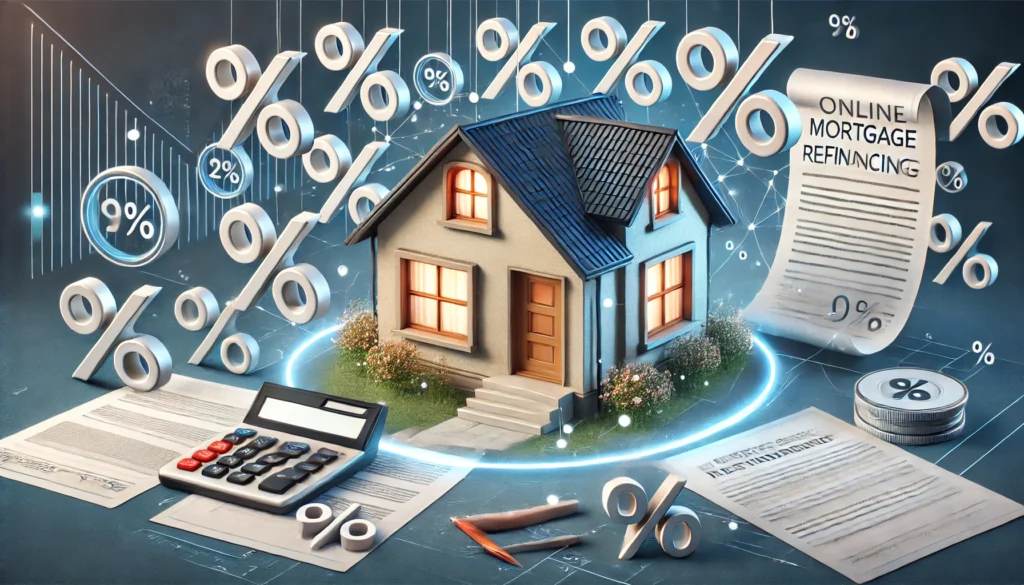The Importance of Refinancing Your Home Loan Online
Refinancing a home loan can be a powerful financial move, especially when done through online platforms that offer convenience, competitive rates, and quick processing times. With digital lending solutions advancing rapidly, homeowners now have more opportunities than ever to secure better mortgage terms from the comfort of their homes. Understanding how online mortgage refinance works, the benefits it offers, and the potential pitfalls to avoid can significantly impact a borrower’s financial stability and long-term wealth-building strategy.
You may also like: Best Student Loan Refinance Options in 2025: Compare Rates & Save Thousands
Online refinancing simplifies the process by allowing homeowners to compare multiple lenders, assess interest rates, and submit applications digitally. Many lenders offer streamlined services that eliminate paperwork, reducing the time it takes to get approval. The advantages of online refinance solutions go beyond convenience; they also include cost savings through reduced fees and access to real-time rate comparisons that help borrowers make informed decisions. By taking advantage of these resources, homeowners can lower their monthly payments, shorten their loan terms, or even cash out home equity to meet other financial goals.

How Online Mortgage Refinance Works
Online mortgage refinance works similarly to traditional refinancing, but it offers greater efficiency and transparency. The process typically starts with researching online lenders and using digital tools to estimate new mortgage terms. Many lenders provide prequalification tools that allow borrowers to check potential rates without impacting their credit scores. This enables homeowners to compare options before committing to a full application.
Once a lender is chosen, borrowers must submit an application online, providing details about their existing loan, credit history, and income. Digital platforms often integrate with financial databases, expediting the verification process. The lender then reviews the application, assesses the borrower’s financial standing, and offers a new loan agreement. E-signature capabilities and digital documentation further streamline the process, reducing the need for physical paperwork and in-person meetings.
Many online refinancing platforms also offer automated loan processing, which accelerates approval times compared to traditional banks. However, borrowers should be mindful of potential costs, including origination fees and closing costs, which can impact overall savings. Evaluating the total cost of refinancing and calculating break-even points are crucial steps in ensuring financial benefits outweigh any fees involved.
Benefits of Refinancing a Home Loan Online
Refinancing a home loan online provides numerous benefits that go beyond just securing a lower interest rate. One of the most significant advantages is cost savings, as many online lenders offer competitive rates with lower overhead costs. By refinancing at a lower rate, borrowers can reduce their monthly payments and overall interest expenses, allowing for greater financial flexibility.
Another key advantage is the ability to customize loan terms to better fit individual financial goals. Borrowers can opt for shorter loan terms to pay off their mortgages faster, reducing the total interest paid over the life of the loan. Alternatively, extending the loan term can lower monthly payments, making homeownership more affordable in the short term. Many lenders also provide options for cash-out refinancing, allowing homeowners to tap into their home equity to cover major expenses such as home renovations, debt consolidation, or education costs.
Additionally, refinancing online often leads to faster processing times, as digital platforms utilize automation and direct financial data access. Unlike traditional lenders, online mortgage refinance services eliminate the need for in-person meetings, extensive paperwork, and lengthy wait times. Borrowers can track their applications in real-time, ensuring transparency and peace of mind throughout the process.
Potential Pitfalls and How to Avoid Them
While refinancing a home loan online offers multiple advantages, there are potential risks that borrowers should consider. One of the primary concerns is hidden fees, which can sometimes offset the savings gained from a lower interest rate. Some lenders charge high origination fees, prepayment penalties, or closing costs that may not be immediately apparent. To avoid unexpected expenses, borrowers should carefully review loan estimates and request detailed breakdowns of all costs before committing to a new mortgage agreement.
Another potential pitfall is choosing the wrong lender. Not all online mortgage refinance providers are reputable, and some may engage in predatory lending practices. Researching lender reviews, checking with regulatory agencies, and verifying licensing can help homeowners identify trustworthy lenders. Comparing offers from multiple sources ensures that borrowers receive the most favorable terms available.
Credit score impact is another consideration. Although prequalification tools allow homeowners to check estimated rates without affecting their credit, submitting multiple full applications within a short period can lead to temporary credit score dips. Borrowers should space out applications and work on improving their credit profiles before applying to secure the best possible terms.
When Is the Right Time to Refinance?
The decision to refinance should be based on multiple factors, including interest rate trends, personal financial goals, and current mortgage terms. Generally, refinancing is most beneficial when interest rates drop significantly compared to a borrower’s existing rate. Even a small reduction in interest rates can lead to substantial savings over the life of the loan.
Another ideal time to refinance is when a homeowner’s credit score has improved. A higher credit score qualifies borrowers for better rates, resulting in lower monthly payments. Similarly, refinancing may be advantageous for those looking to switch from an adjustable-rate mortgage (ARM) to a fixed-rate mortgage for greater stability.
Refinancing is also a smart option for homeowners looking to consolidate high-interest debt. By utilizing home equity to pay off credit card balances or personal loans, borrowers can reduce overall interest expenses and simplify debt management. However, refinancing for debt consolidation should be approached cautiously, ensuring that long-term savings outweigh the risks of extending mortgage obligations.

Frequently Asked Questions (FAQ) on Online Home Loan Refinancing
1. What are the main benefits of choosing a home loan refinance online?
Refinancing a home loan online provides convenience and efficiency that traditional methods often lack. By opting for an online refinance, borrowers can compare multiple lenders, explore competitive interest rates, and complete the application process from the comfort of their homes. Many online mortgage refinance platforms use advanced algorithms to match borrowers with the most suitable loan products based on their financial profile. Additionally, digital applications often streamline documentation and approval processes, reducing the time required to finalize the refinance. This not only saves borrowers money but also ensures a seamless transition to a lower mortgage rate or better loan terms.
2. How does an online refinance differ from a traditional refinance process?
An online mortgage refinance typically eliminates much of the paperwork and face-to-face meetings associated with traditional refinancing. Online platforms often use automated verification systems to assess income, credit history, and home value, expediting the approval process. Traditional refinancing may require multiple in-person meetings with loan officers, whereas an online refinance allows borrowers to submit documents digitally and communicate through secure online portals. Additionally, online lenders frequently offer more competitive rates since they have lower overhead costs compared to brick-and-mortar institutions. This results in potential savings for homeowners while maintaining the same level of financial security and compliance.
3. Is it safe to complete a home loan refinance online?
Yes, online refinancing is safe when conducted through reputable lenders and secure platforms. Most online mortgage refinance lenders use advanced encryption, multi-factor authentication, and secure document upload portals to protect borrowers’ sensitive information. Additionally, regulatory agencies ensure that online lenders adhere to the same legal and ethical standards as traditional financial institutions. Before proceeding with an online refinance, borrowers should research lender reviews, verify licensing, and avoid offers that seem too good to be true. By choosing a well-established online platform, homeowners can safely and efficiently refinance their mortgage while enjoying the benefits of digital convenience.
4. What documents are needed for an online mortgage refinance?
While the specific requirements may vary by lender, most online refinance applications require standard documentation such as proof of income, tax returns, credit reports, and home appraisal information. Many lenders allow digital submission of pay stubs, bank statements, and employment verification forms, significantly reducing processing time. Online mortgage refinance platforms often integrate with financial institutions to automatically retrieve certain documents, eliminating the need for manual uploads. Some lenders may also request additional documentation for self-employed borrowers or those with non-traditional income sources. Understanding the required paperwork in advance can help streamline the online refinance process and prevent delays.
5. How long does it take to complete an online refinance?
The timeline for an online mortgage refinance varies depending on the lender, the complexity of the borrower’s financial situation, and the speed of document submission. On average, an online refinance can take anywhere from two to six weeks to complete, significantly shorter than traditional refinancing methods. Automated underwriting and digital processing allow lenders to approve applications faster, particularly for borrowers with strong credit histories and stable income. Homeowners who promptly provide necessary documents and respond to lender inquiries can further expedite the process. Choosing an experienced online lender with a streamlined system can make refinancing both quick and hassle-free.
6. Can you refinance if you have bad credit through an online lender?
Yes, some online mortgage refinance lenders specialize in working with borrowers who have less-than-perfect credit. While a lower credit score may result in higher interest rates, refinancing can still be beneficial if it leads to lower monthly payments or better loan terms. Many online platforms offer pre-qualification tools that allow borrowers to check potential loan offers without impacting their credit score. Additionally, improving financial habits—such as paying down debts and making on-time payments—before applying for an online refinance can increase the likelihood of approval. Exploring different online lenders can help homeowners find refinancing options that best suit their financial situation.
7. Are there closing costs associated with an online refinance?
Yes, just like traditional refinancing, a home loan refinance online often involves closing costs, which can include lender fees, appraisal charges, and title services. However, many online mortgage refinance lenders offer “no-closing-cost” options, which allow borrowers to roll these expenses into the loan balance or accept a slightly higher interest rate. Comparing different online lenders and negotiating closing costs can help homeowners save money during the refinance process. Understanding the breakdown of fees and ensuring there are no hidden costs will allow borrowers to make informed financial decisions. Some lenders also offer promotional deals or discounts that can further reduce refinancing expenses.
8. Can you refinance an investment property online?
Yes, online mortgage refinance options are available for investment properties, though they may come with stricter requirements than primary residence refinances. Online lenders typically assess the borrower’s creditworthiness, rental income, and property value before approving an investment property refinance. While interest rates for investment property refinancing tend to be slightly higher than for primary residences, online platforms provide a convenient way to compare multiple lenders and secure competitive rates. Additionally, some lenders allow cash-out refinancing, enabling property owners to access equity for renovations or further real estate investments. Researching online refinance options for investment properties can help maximize long-term profitability.
9. How can online refinancing help homeowners save money?
Online refinancing helps homeowners save money by offering access to competitive interest rates, reducing monthly payments, and lowering total loan costs. Digital lenders often have lower operating expenses, allowing them to pass savings on to borrowers in the form of reduced fees and lower interest rates. Additionally, refinancing through an online mortgage refinance platform allows homeowners to compare multiple lenders, ensuring they secure the best possible deal. Borrowers who refinance at the right time—such as when interest rates drop—can significantly reduce their financial burden over the life of the loan. By leveraging online refinance tools, homeowners can optimize their mortgage terms and achieve greater financial stability.
10. What should you consider before choosing an online refinance lender?
Before selecting an online mortgage refinance lender, homeowners should evaluate factors such as interest rates, fees, lender reputation, and customer service quality. Reading customer reviews and checking the lender’s Better Business Bureau (BBB) rating can provide insight into their reliability and responsiveness. Additionally, understanding the lender’s refinancing process, including timelines and documentation requirements, can help ensure a smooth experience. Comparing multiple online refinance offers and asking about any potential hidden fees will help borrowers make an informed choice. Selecting a trusted online lender with competitive rates and excellent service can lead to a successful and financially beneficial refinancing experience.

Final Thoughts: Making an Informed Decision
Refinancing a home loan online offers numerous financial benefits, from lowering interest rates and monthly payments to customizing loan terms for greater flexibility. The digital lending landscape has made online mortgage refinance more accessible, transparent, and efficient than ever before. However, careful evaluation of loan terms, potential fees, and lender credibility is essential to making a sound financial decision.
Before proceeding with an online refinance, borrowers should assess their long-term financial goals, consider the timing of refinancing based on interest rate trends, and compare multiple lender offers. By leveraging digital tools, prequalification calculators, and transparent lender reviews, homeowners can confidently navigate the refinancing process and maximize their savings.
Tags
mortgage refinancing strategies, best home loan refinance options, refinancing a home loan online, digital mortgage lenders, home loan interest rate reduction, refinancing vs. loan modification, mortgage rate comparison, home equity and refinancing, online loan application process, benefits of refinancing a mortgage, best online mortgage lenders, refinancing costs and savings, how to lower mortgage payments, refinancing home loan calculator, choosing a mortgage refinance lender, home loan refinancing tips, refinancing eligibility criteria, mortgage refinancing risks, digital home loan approval, refinancing for better financial management
Further Reading:
Ask Yourself – What is Home Loan Refinancing?
Myths of Home Refinancing Busted
6 Reasons to Opt for Home Loan Refinance
Legal Disclaimer
The information provided in this article is for general informational purposes only and is not intended to constitute financial, investment, legal, tax, or other professional advice. The content should not be relied upon for making any financial or investment decisions. Readers are encouraged to consult with licensed professionals, such as financial advisors, attorneys, or tax experts, to obtain personalized advice tailored to their individual circumstances. The author and publisher disclaim any liability for any actions taken or not taken based on the information provided in this article.





